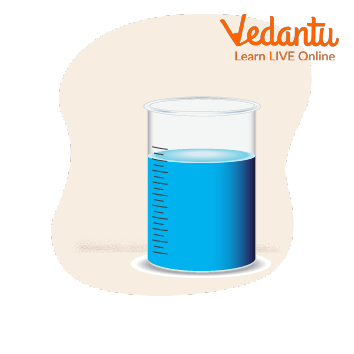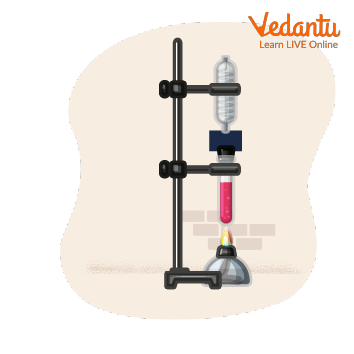




Beaker Facts: Functions, Sizes, and How to Use Them Safely
Before starting this article first we will learn what a beaker is and what a beaker looks like. A beaker is typically a cylindrical container with a flat bottom used in lab equipment. Most also have a tiny spout (or "beak") to enable pouring, as seen in the image below. Beakers come in a huge variety of sizes, ranging from one millilitre to several litres.
Because its sides are straight as opposed to sloping, a beaker can be distinguished from a flask. The Philips beaker, a beaker with slightly conical sides, is an exception to this rule. In most drinkware, the beaker shape is present. We are also going to discuss what a beaker is used for, what beakers are used for in science, and beakers used in chemistry labs.

Beaker used in Chemistry Lab
What does a Beaker Look Like?
Beakers are frequently made of glass but they can also be made of metal (such as stainless steel or aluminium), or some plastics. Beakers used in laboratories are vessels in which liquid is kept so that it can easily be mixed or heated.
The bottom of the beaker is flat in appearance. On the tip, a small depression is made for pouring liquid or solutions. Low-form beakers have a height of about 1.4 times the diameter. It is also known as the Gryphon beaker. These are used for different purposes. Tall form beakers have a height of about twice their diameter. Flat beakers are known as crystallizers.
What is Beaker Used for in Science?
Beakers can be used to hold liquid or solid samples or as a container for reactions. They are also used to collect filtrates from filtering operations as well as liquids from titrations. It is used for stirring the liquid. It is useful as a reaction container. They are also used to catch liquids.

Beaker Attached on the Stand
Beaker Used in Chemistry Lab
Different types of beakers used in chemistry lab are the following:
Gryphon beaker
Berzelius beaker
Crystallizer
Beaker Facts
Some beakers have marks present on them to represent how much volume of liquid they hold.
Beakers commonly have the same width as their height.
Beakers are also used to make solutions.
Beakers are the most used laboratory equipment.
The liquid is slowly poured into the beaker to avoid splashing.
The liquid inside the beaker is mixed with the help of a stirrer.
Lab Safety Rules for Kids While Using Beaker
Do not touch any chemicals present in the beaker unless you are allowed to do so.
Never work in a science lab in the absence of your lab attendant.
Please follow all the written and verbal instructions before and during using a beaker.
Do not touch your face, eyes, or any body parts after touching the beaker in which any kind of chemical or solution is present.
Always wear a lab coat when you are doing any type of experiment in the laboratory.
Never touch a hot beaker with your hands, let them cool down.
If any accident happens while using a beaker, tell your teacher about that. Please do not panic.
Summary
Beaker is laboratory equipment. It has many different uses and purposes. There are many other laboratory devices also present like beakers. Here, in this article, we have discussed all the details about beaker chemistry. We have already mentioned how beakers are used. Beakers can be made up of different materials, in this article, all those materials have been explained. Different sizes of beakers are available and sizes are selected according to the use. All the beakers used in the chemistry lab are also declared in this article. This article is very beneficial to you as you are getting all the detailed knowledge about the beaker.
FAQs on What Is a Beaker in Chemistry? Definition, Uses & Importance
1. What is a beaker and what are its primary uses in a science lab?
A beaker is a common piece of laboratory equipment, typically a cylindrical container with a flat bottom and a small spout for pouring. Its main uses in a science lab include:
- Holding and mixing liquids or solid samples.
- Carrying out simple chemical reactions.
- Heating substances over a Bunsen burner (if made of appropriate glass).
- Collecting liquids during experiments like filtration.
2. What do the markings on the side of a beaker represent?
The markings on the side of a beaker, called graduations, indicate the approximate volume of the liquid inside. These lines are meant for estimation and general-purpose work, not for precise measurement. For example, they are useful for mixing roughly 100 ml of water with another substance where exactness is not critical.
3. Why is a beaker not suitable for precise volume measurements like a graduated cylinder?
A beaker is unsuitable for precise measurements because of its wide diameter, where a small error in reading the liquid level results in a large error in the measured volume. The graduations are only approximate, often with a tolerance of ±5%. For accuracy, a graduated cylinder or a volumetric flask is used, as their narrow shapes allow for much greater precision.
4. What is the difference between a beaker and a flask?
The main difference lies in their shape and function. A beaker is a wide, cylindrical container with straight sides, ideal for simple mixing and transferring liquids. In contrast, an Erlenmeyer flask has a flat bottom, a conical body, and a narrow neck. This narrow neck is designed to prevent splashes during swirling or boiling and to reduce evaporation, making it better for titrations and heating volatile liquids.
5. Why is it important to use a beaker made of borosilicate glass for heating?
It is crucial to use a beaker made of borosilicate glass (like Pyrex) for heating because it has a very low coefficient of thermal expansion. This property means it does not expand or contract significantly when its temperature changes. Regular glass would likely crack or shatter from the thermal shock of being heated by a flame and then cooling down, posing a significant safety hazard in the lab.
6. How does the wide mouth of a beaker make it useful for certain experiments?
The wide mouth of a beaker is a key design feature that makes it very easy to add or remove substances, whether they are solids, liquids, or powders. It also allows for easy stirring with a glass rod and provides clear access for placing instruments, such as a pH meter or thermometer, directly into the solution. This accessibility is why beakers are often preferred for preparing solutions.
7. Can you use a beaker to store chemicals long-term? Why or why not?
No, a beaker should not be used for long-term chemical storage. Its wide, open mouth allows for easy contamination from dust, debris, and other particles in the air. It also leads to a high rate of evaporation, which can change the concentration of a solution. For storage, one must use a container with a proper lid or stopper, such as a reagent bottle.





















